Picking the right hardware for a residential fire sprinkler system
Home fires account for 27% of all reported fires, but they are disproportionately deadly. The National Fire Protection Association (NFPA) reports that 79% of fire deaths and 73% of fire injuries happen at home.
Residential fire sprinklers save lives and prevent injuries; in the “US Experience with Fire Sprinklers,” NFPA says that the death rate per 1,000 fires drops by 81% when some kind of automatic extinguishing system is present in a residence. It’s surprising, then, that so few homes have sprinklers; they are present in only 7% of home structure fires.
Whether it’s a retrofit project or part of a new home, installing a residential fire sprinkler system is an investment in safety and security. And it’s always essential to use the right tool for the job. Every building is unique, so residential fire sprinkler systems may have to meet different needs. Before you shop for sprinklers, consider what features are needed, including:
- The kinds of spaces you are protecting
- The maximum anticipated temperatures
- K-factor
- Style and aesthetic
Getting the right sprinklers ensures that the system works as intended and remains code-compliant. This article looks to NFPA 13D: Standard for the Installation of Sprinkler Systems in One- and Two-Family Dwellings and Manufactured Homes and NFPA 13: Standard for the Installation of Sprinkler Systems for the detailed rules.
If you already know what sprinkler features you need, shop our selection of residential fire sprinklers from Viking, Victaulic, Tyco, and Senju. We have decorative concealed sprinklers plus horizontal sidewall and pendent sprinklers in a variety of finishes.
Matching sprinkler types to different residential spaces
Residential sprinkler systems need “residential” sprinklers, right? Most of the time, that’s correct. But there are some situations where other sprinkler types are allowed and could be useful. This section explains what a residential sprinkler is and the rules NFPA 13D has for the use of fast-response sprinklers and dry sprinklers in residential settings.
Residential sprinkler heads activate fast and are built for a specific purpose
The basic principle of all fire sprinklers is the same—a heat-sensitive element deforms or breaks from elevated temperatures, unplugging the sprinkler and releasing water. But while they use the same mechanisms, residential and commercial sprinklers have slightly different jobs.
Instead of being general property protection systems, residential sprinkler systems are explicitly life safety systems designed to make the places they protect more survivable in the event of a fire. Residential sprinklers are specially-designed for this purpose.
A residential fire sprinkler, as NFPA 13D says, has three features (3.3.11.2):
- It is a fast-response sprinkler
- It is “specifically investigated for its ability to enhance survivability in the room of fire origin”
- It is listed for use in dwelling units
Some people incorrectly think that residential sprinklers are just “quick-response sprinklers.” The distinction is subtle. “Fast response” is an umbrella term for all sprinklers with a Response Time Index (basically, a measure of how quickly they respond to heat in the environment) of 50 or less. Quick-response sprinklers, Early Suppression Fast Response (ESFR) sprinklers, and residential sprinklers are all “fast response.”
Despite the shared “fast response” designation, these sprinklers can do fundamentally different jobs, which is evident in how they spray water. Many quick-response sprinklers perform the floor-wetting function of standard-spray commercial sprinklers. ESFR sprinklers, with massive k-factors of 14 or more and deflectors that produce combined jet and cone spray patterns, are designed to handle warehouse fires.
Residential sprinklers, the go-to choice for dwelling units, discharge water at a higher angle than other sprinklers, wetting the walls rather than the floor. This helps deprive the fire of fuel and create a livable space to give occupants time to escape.
Sprinklers for unoccupied or unheated space
But wait! There IS a place for other types of sprinklers in residential sprinkler systems. Residential sprinklers ensure that living spaces remain livable, but not every part of the house is a living space. If you want to protect garages, attics, machine rooms, or other such areas, you can reach for different kinds of equipment. NFPA 13D says:
7.5.3 Listed residential or quick-response standard spray dry pendent or dry sidewall sprinklers shall be permitted to be extended into unheated areas not intended for living purposes.
7.5.4 Quick-response sprinklers shall be permitted to be used in mechanical closets.
Sprinklering a mechanical room could be a very good idea—heating and electrical equipment was the second (14%) and third (12%) most common causes of home structure fires between 2013 and 2017. In mechanical closets, quick-response sprinklers that are not necessarily residential models are permitted.
Though model standards do not require it, it could also be a smart idea to sprinkler spaces like attics and garages—and some state and local codes have this requirement. Especially in cold climates, pipes in these spaces can be vulnerable to freezing. This makes them difficult to protect with sprinklers. Fortunately, NFPA 13D allows for the use of dry-barrel sprinklers.
Specially-designed dry sprinklers connected to wet systems can prevent freezing without the mess and hassle of antifreeze or a full dry sprinkler system. Dry sprinklers have an air-filled “dry barrel” behind the sprinkler head, and the presence of the heat-sensitive element (glass bulb or link) holds pressure on a spring, keeping an inlet valve at the top of the barrel shut. The dry barrel passes through a wall or ceiling to a heated space, connecting to the rest of the sprinkler system. When the sprinkler operates—the bulb or link breaks—the pressure on the spring is released, opening the inlet at the top of the barrel. Water flows from the pipes in the structure’s heated area, through the barrel, and out of the sprinkler head.
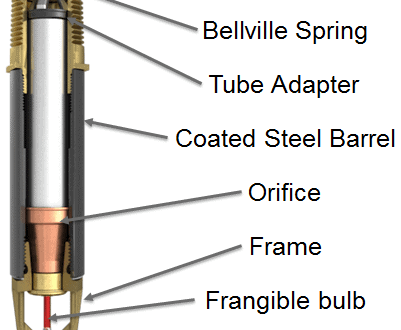
Sprinkler temperature rating
Fire sprinklers operate at specific temperatures. As such, they are rated for different environments so that there’s a contrast between the normal ambient temperature and the activation temperature. Sprinklers with an “Ordinary” temperature rating can be safely used where ceiling temperatures won’t exceed 100 °F. NFPA 13’s rules for the max ceiling temperatures are summarized below:
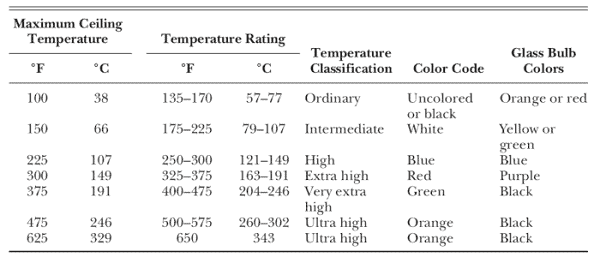
For a residential sprinkler system, ordinary temperature-rated sprinklers will do the job most of the time.
However, NFPA 13D (7.5.6.3) outlines several scenarios where residential sprinkler heads should have a higher temperature rating than average:
- Sprinklers under glass or plastic skylights should be rated for intermediate temperatures
- Sprinklers in unventilated concealed spaced under an uninsulated room should be rated for intermediate temperatures
- Sprinklers in unventilated attics should be rated for intermediate temperatures
- Sprinklers in closes with ventless clothes driers should be rated for intermediate temperatures or higher
- Sprinklers in saunas and steam rooms should have a high-temperature rating
In addition, consider how near the sprinkler will be to various heat sources like fireplaces, wood-burning stoves, kitchen ranges, hot water pipes, and light fixtures. If the sprinkler is close, you might need to use an intermediate sprinkler instead of an ordinary sprinkler. This table has NFPA 13D’s rules on sprinkler proximity to heat sources.
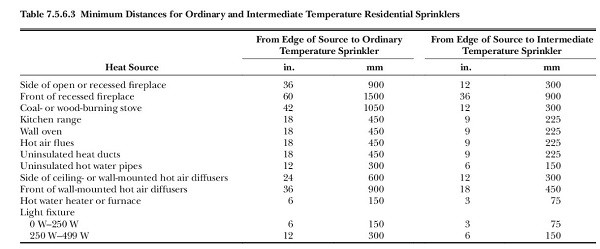
Pick residential sprinkler heads with the right K-factor
In fire sprinkler systems—residential or commercial—the pressure is everything. You need enough force behind the sprinkler head to achieve sufficient water flow and density. A sprinkler’s K-factor is one aspect of hydraulic design—a bigger value means a larger orifice and more flow at a given pressure. Picking the right K-factor for a residential sprinkler is important.
Standard residential water pressure is between 40 and 80 psi before losses. Because NFPA 13D applies to one- and two-family dwellings (not big buildings), pressure losses from elevation and pipe friction are usually small. Thus, residential sprinkler heads don’t typically come with the high K-factors used in commercial settings to achieve sufficient flow despite pressure losses.
Instead, home sprinklers usually have K-factors between 3.0 and 5.8, with small increments in between. This gives designers and technicians lots of options for achieving the required flow and density, which is especially valuable when the coverage demands and available pressure can vary significantly between projects.
Consider concealed sprinklers for residential fire sprinkler systems
Aesthetics are especially important in the home, as owners don’t want sprinklers to clash with their décor. When picking heads for their decorative appeal, cosmetic finishes are available on regular pendent and sidewall sprinklers. But don’t forget about concealed sprinkler heads.
Concealed models are very popular in residential settings. Their function is simple. Usually, a decorative but heat-sensitive cover plate hides the head. In the event of a fire, the cover plate drops away before the sprinkler activates by having a slightly lower temperature rating.
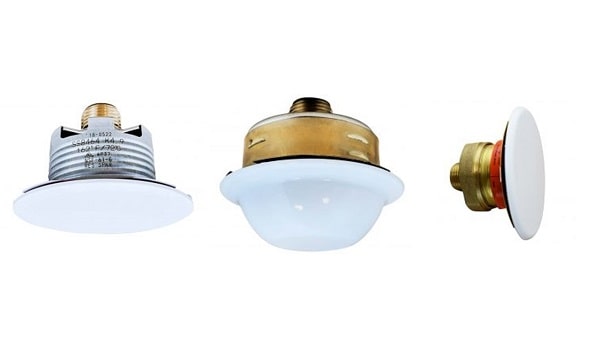
Concealed sprinklers are popular because they are unobtrusive. Most people don’t give concealed models a second glance because they blend in so well.
Sprinkler manufacturers like Viking, Victaulic, and Tyco manufacture cover plates in various standard colors and ship custom colors on request. Viking can also do custom artwork prints. Senju cover plates come in a similar variety of colors, decorative wood patterns, and custom colors and patterns.
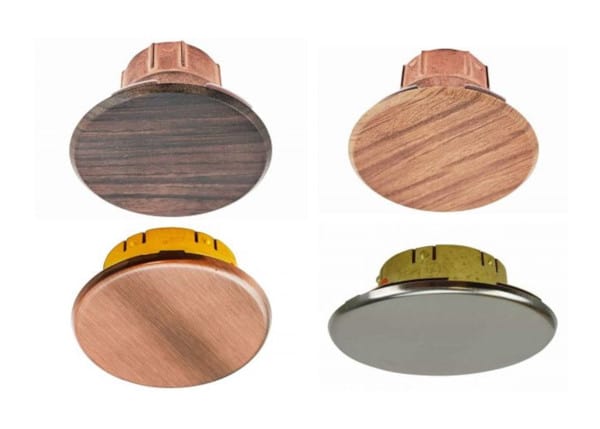
Concealed sprinklers are also protected from damage. With the head safely behind the cover plate, no one can use them to hang clothes, and they are less likely to be hurt by an indoor soccer game.
QRFS has the right parts for residential fire sprinkler systems
A sprinkler system is an investment in safety, so it’s essential to get the right residential sprinkler heads.
When purchasing fire sprinklers for a home sprinkler system, consider the type of sprinklers that you need. Most of the time, standard residential models are what you need, but certain quick-response and dry barrel sprinklers may have their places.
Temperature rating is another crucial factor—specific heat sources may require sprinklers to be rated for intermediate or high temperatures.
In all sprinkler systems, K-factor is a vital specification for sprinklers. When you shop for residential sprinklers, you’ll find many options within a small numeric range.
Finally, concealed sprinkler heads can be good aesthetic and functional choices.
QRFS has the residential sprinklers you need from manufactures like Viking, Victaulic, Tyco, and Senju. Our decorative concealed sprinklers meet any cosmetic need, and our horizontal sidewall and pendent sprinklers come in a variety of finishes. To inquire about custom paint finishes or niche products like dry-barrel sprinklers, don’t hesitate to contact us!
This blog was originally posted at blog.qrfs.com. If this article helped you, check us out at Facebook.com/QuickResponseFireSupply or on Twitter @QuickResponseFS.


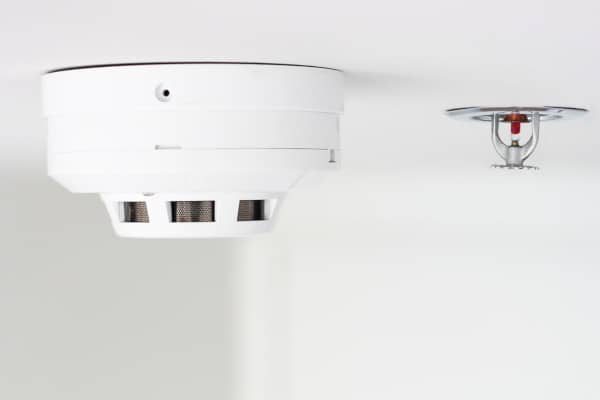
General fire sprinkler system inspection question (NFPA 25):
Who pays the claim if an insurance company makes a recommendation for a 5-year pressure test on a system (Including fire department connection) and problems occur.? If leakage occurs and creates damage does the property owners insurance company pay for the loss or the fire sprinkler contractors insurance company?
Thank you. Happy new year and no rush for an answer.
Bob Meagher
Bob — Honestly, we can’t answer that definitively or professionally, as this is a question suited for insurance adjusters (who may challenge each other). But one could suppose they will look for who (if anyone) is at fault for *or* fundamentally bears the risk responsibility for the underlying conditions that caused the leakage (such as time-based wear and tear, corroded pipe, or improperly-joined fittings). Please note that the 5-year hydrostatic test is designed to look for leaks and catch failures before they happen in an emergency situation. And it’s likely not possible to predict where those failures will occur within a system. Thus, it sounds like the test did its job.
Contact the relevant insurance companies and see what they say. Best of luck!
My apartment has ugly and cheap sprinklers installed everywhere. Is it typically possible to retrofit concealed sprinklers?
I’m particularly concerned about how easily the pendant style can be damaged because someone in my building had a lot of water damage in their apartment after accidentally knocking a sprinkler head.
Jenna — It’s possible to retrofit concealed sprinklers, but it may not be feasible and cost effective. Essentially, the pendents you see sticking out of the ceiling or wall are a specific distance from the supply pipe via a rigid fitting that’s a certain length (drop). Depending on the position of the wall or ceiling relative to the supply pipe, those rigid connections would need to be resized and replaced. Another option would be using flexible drops that allow easier positioning, but if the building doesn’t already have them, they would need to be put in. Another potential way to account for this would be if there are drop ceilings. Regardless, it is possible to replace exposed sprinklers with concealed models, but it may not be simple or, at least, inexpensive. Your best bet is to run the scenario by a qualified local fire sprinkler pro. Thanks for reading!